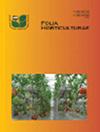玫瑰果基因型的生化组成和形状维度特征
IF 1.8
4区 农林科学
Q2 HORTICULTURE
引用次数: 5
摘要
摘要本研究对25个玫瑰果(Rosa canina)基因型的生化组成、形状和尺寸特征进行了研究。通过图像处理技术确定其形状和尺寸特征。从Mesudiye(Ordu)和Talas(Kayseri)地区的自然植物区系中收集了属于犬R.canina的种子繁殖玫瑰果基因型。抗氧化活性(39.510–72.673 mmol·kg−1)、总黄酮(287.80–1686.20 mg槲皮素当量(QE)·kg−2)和总酚(38519.40–79080.60 mg没食子酸当量·kg−3)的基因型差异较大。发现果实平均宽度(12.2毫米)和厚度(12.5毫米)彼此接近。基因型的果实长度在12.0mm到29.5mm之间。水平方向的平均投影面积(179.7mm2)大于垂直方向的投影面积(120.4mm2)。球度平均值为71.4%。根据主成分分析,区分基因型的最重要尺寸性状是表面积、几何平均直径和体积。在形状属性方面,基因型的球形度、圆形度、伸长率和表面闭合率(SCR)存在显著差异。根据椭圆傅立叶分析(EFA),基因型看起来像一个球体。就形状而言,有长的、球形的、平底的、尖底的和不对称的基因型,表明环境和基因型如何影响果实形状。最大的形状变化是横向收缩和扩张。根据形状属性的聚类分析,将玫瑰果基因型分为六组。树状图、线性判别分析散点图和配对比较试验结果成功地揭示了基因型的形状差异。本文章由计算机程序翻译,如有差异,请以英文原文为准。
Biochemical composition and shape-dimensional traits of rosehip genotypes
Abstract In the present study, the biochemical composition and shape and dimensional traits of 25 rosehip (Rosa canina) genotypes were investigated. The shape and dimensional traits were determined by image processing technique. Seed-propagated rosehip genotypes belonging to R. canina were collected from the natural flora of Mesudiye (Ordu) and Talas (Kayseri) districts. Antioxidant activity (39.510–72.673 mmol · kg−1), total flavonoids (287.80–1,686.20 mg quercetin equivalent (QE) · kg−1) and total phenolics (38,519.40–79,080.60 mg gallic acid equivalent · kg−1) of the genotypes exhibited large variations. Width (12.2 mm) and thickness (12.5 mm) of fruits averages were found to be close to each other. The genotypes exhibited fruit lengths between 12.0 mm and 29.5 mm. Average projected area at horizontal orientation (179.7 mm2) was greater than the projected area at vertical orientation (120.4 mm2). Sphericity average was calculated as 71.4%. According to principal component (PC) analysis, the most important dimensional traits discriminating genotypes from each other were identified as surface area, geometric mean diameter and volume. In terms of shape attributes, distinctive differences were observed in sphericity, circularity, elongation and surface closure rates (SCR) of the genotypes. According to elliptic Fourier analysis (EFA), genotypes look like a sphere. In terms of shape, there were long, spherical, flat bottomed, pointed bottomed and asymmetric-looking genotypes indicating how environment and genotype affect the fruit shape. The greatest shape variation was transverse contraction and expansion. According to the clustering analysis for shape attributes, rosehip genotypes were classified into six groups. Dendrogram, scatter plots of linear discriminant analysis and paired comparison test results put forth the shape differences of the genotype successfully.
求助全文
通过发布文献求助,成功后即可免费获取论文全文。
去求助
来源期刊

Folia Horticulturae
Agricultural and Biological Sciences-Horticulture
CiteScore
3.40
自引率
0.00%
发文量
13
审稿时长
16 weeks
期刊介绍:
Folia Horticulturae is an international, scientific journal published in English. It covers a broad research spectrum of aspects related to horticultural science that are of interest to a wide scientific community and have an impact on progress in both basic and applied research carried out with the use of horticultural crops and their products. The journal’s aim is to disseminate recent findings and serve as a forum for presenting views as well as for discussing important problems and prospects of modern horticulture, particularly in relation to sustainable production of high yield and quality of horticultural products, including their impact on human health.
 求助内容:
求助内容: 应助结果提醒方式:
应助结果提醒方式:


